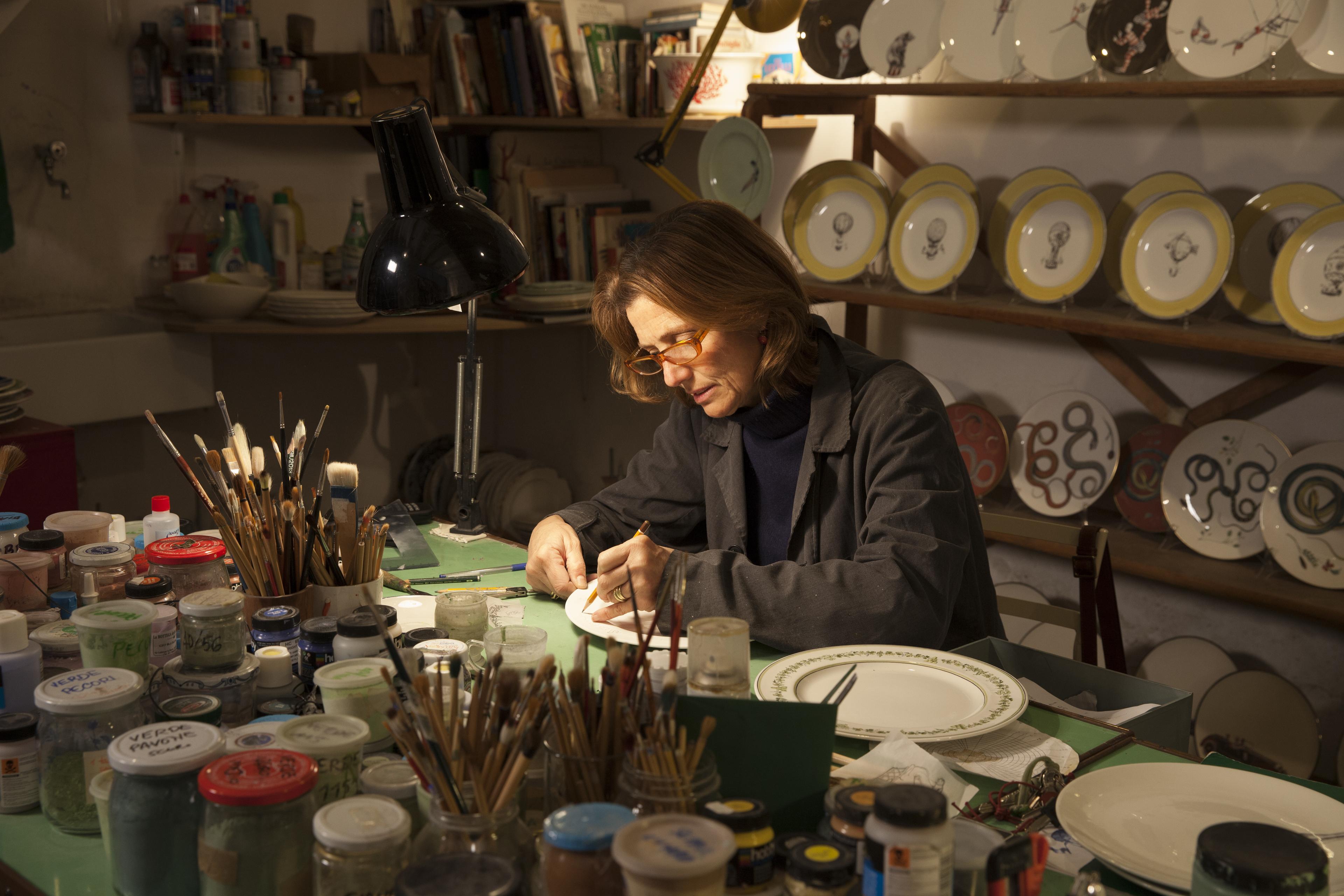
Scultura in velluto di pesce gioioso rosa
3400 EUR
Spedizione in 3-4 settimane

Incontrate l'artista veneziana Anna Paola Cibin e scoprite come crea pezzi decorativi unici dipingendo su velluto, una tecnica ispirata all'antica tradizione degli arazzi veneziani. Il suo talento, la sua passione e la sua costante ricerca dei dettagli producono opere d'arte del tutto originali e accattivanti che fondono elementi in vetro veneziano, decorazioni in foglie d'oro e d'argento su preziosi velluti.
Il contenuto di questa pagina è stato tradotto automaticamente. Vai al sito in inglese
L'artista veneziana Anna Paola Cibin ha studiato arte e design all'Istituto d'Arte di Venezia. Dopo un breve periodo a Londra, è tornata a Venezia per collaborare con i maestri vetrai di Murano e nel 1997 ha iniziato a dipingere su velluto, una tecnica ispirata all'antica tradizione degli arazzi veneziani. Il suo talento, la sua passione e la sua costante ricerca dei dettagli producono opere d'arte del tutto originali e accattivanti che fondono elementi in vetro veneziano, decorazioni in oro e foglie d'argento su lussuosi velluti. Le sue opere sono state esposte a Vienna, Parigi, Londra, New York e Singapore.
Leggete la nostra intervista ad Anna Paola Cibin sulla rivista Artemest e scoprite il suo processo di produzione, il suo amore per il velluto e dove trova la sua ispirazione.
Come si è avvicinato al mondo dell'artigianato?
Fin da bambino sono stato affascinato da tutti quei lavori che richiedono abilità manuale, conoscenza delle materie prime e senso di creatività. Direi che è quasi una "questione di famiglia": Aiutavo mio padre, restauratore di mobili e falegname, e giocavo con i campioni delle stoffe che mia madre usava per creare abiti e costumi. I miei genitori mi hanno mostrato l'importanza di lavorare sodo anche per le cose più piccole e mi hanno insegnato ad amare ciò che si fa e a farlo con arte.
Cosa ispira i paesaggi astratti delle sue opere?
A volte le immagini appaiono già completamente formate nella mia mente, senza che io le abbia pensate; altre volte sono ispirata da un colore particolare, o dal dettaglio di un oggetto, o di una fotografia. Quasi sempre, però, la mia idea inizia a prendere forma dal mare, dai suoi colori e dai movimenti sinuosi dei pesci.
Perché ha scelto la tecnica pittorica del velluto?
Cosa la affascina di più di questo materiale così raffinato? Mi sono iscritta all'Istituto d'Arte di Venezia, nel dipartimento di Tessitura, e pur sapendo che avrei dovuto lavorare con i tessuti, non sapevo ancora come, finché non ho imparato a tingere il velluto: in quel momento ho scoperto che il velluto sarebbe stato il "mio" tessuto. Da allora, ho studiato la storia della colorazione e della stampa sugli antichi arazzi veneziani, che veniva effettuata utilizzando blocchi di legno. Dopo aver perfezionato questa tecnica, mi sono resa conto che non era sufficiente per esprimere tutte le mie idee e ho iniziato a creare degli strumenti di lavoro e delle spatole che avrei poi utilizzato per imprimere il colore sul velluto: è così che ho concepito la mia tecnica di pittura su velluto. Il velluto non può essere dipinto con pennelli morbidi, quindi i miei piccoli strumenti sono diventati una sorta di "pennelli duri". Ogni volta che tingo il velluto di seta bianco con i colori, entro in un'atmosfera magica. Quando è colorato, il velluto di seta diventa iridescente, gioca con la luce a volte creando o nascondendo il disegno principale o i dettagli in vetro. Ogni volta che completo un'opera, credo di averne appena realizzato la prima metà, perché la seconda metà viene riempita dalla luce, conferendole riflessi inaspettati.
Ci parli del processo di produzione di una delle sue opere.
Prima di tutto preparo il velluto e le tinture. Preparo i pigmenti. Di solito non ho nemmeno bisogno di provarli prima, perché il colore giusto è sempre immediato. Raramente capita che il colore non venga come volevo, e in quel caso rinuncio temporaneamente e ricomincio il giorno dopo. In secondo luogo, immergo il velluto nell'acqua e lo muovo in base all'effetto e all'intensità che voglio ottenere. Dopodiché lo appendo e lo lascio asciugare a lungo prima di stenderlo e fissarlo sul tavolo per iniziare a dipingerlo lentamente. Questa tecnica pittorica prevede vari strati e sovrapposizioni. L'immagine che avevo pensato in precedenza cambia in parte sulla superficie di velluto, assumendo una forma istintiva. Poi, lascio asciugare per almeno due giorni, e quindi assemblo o lavoro direttamente su di essa a seconda che si tratti di un arazzo, di un paravento o di un cuscino. All'ultimo momento aggiungo vetro, murrine o foglia d'oro.
C'è un progetto particolare che desidera realizzare con le sue opere?
Vorrei creare un'opera pubblica, qualcosa che possa essere condivisa, di cui le persone possano sentirsi parte, e vorrei realizzarla a Venezia, la mia città... ma ci sto già lavorando.
Quali sono i luoghi da non perdere durante un primo viaggio a Venezia?
La prima volta a Venezia bisogna assolutamente provare il giro in vaporetto di notte lungo il Canal Grande. Sembra un sogno. Bisogna anche andare al mercato del pesce di Rialto alle sette del mattino, passeggiare per il Ghetto ebraico e nei dintorni, dove si respira l'atmosfera locale, piena di "Bacari", tipici bar veneziani da non perdere.

3400 EUR
Spedizione in 3-4 settimane

600 EUR
Spedizione in 3-4 settimane

10.000 EUR
Spedizione in 3-4 settimane

600 EUR
Spedizione in 3-4 settimane

1000 EUR
Spedizione in 3-4 settimane

Radicato in una secolare tradizione artigianale italiana ma guidato da una costante sperimentazion…

Nato dalla passione della famiglia Sali per i tessuti pregiati alla fine degli anni '50, Biancoper…